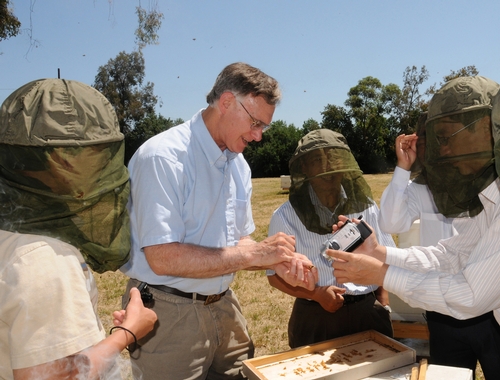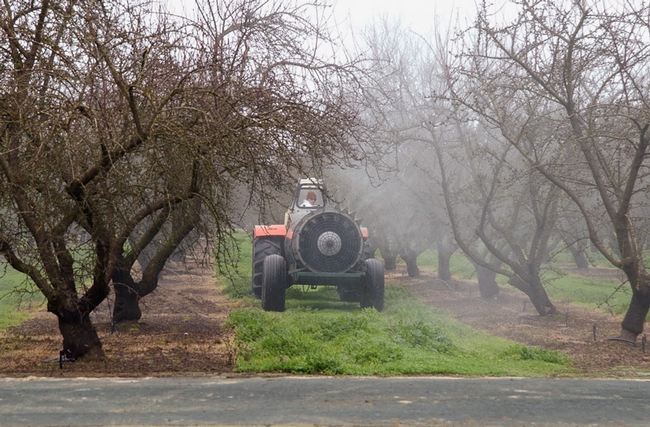Posts Tagged: pesticides
UCLA study links pesticide exposure to Parkinson's disease
UCLA scientists have found that people whose workplaces were close to fields sprayed with the pesticides ziram, maneb and paraquat -- not just those who live nearby -- are at higher risk of developing Parkinson's disease, reported the Los Angeles Times.
The disease has been reported to occur at high rates among farmers and in rural populations, contributing to the hypothesis that agricultural pesticides may be partially responsible, said a UCLA news release about the study.
The researchers discovered that combined exposure to the three pesticides increased the risk of Parkinson's disease threefold, while combined exposure to ziram and paraquat alone was associated with an 80 percent increase in risk. The results appear in the current online edition of the European Journal of Epidemiology.
Scientists already knew that in animal models and cell cultures, such pesticides trigger a neurodegenerative process that leads to Parkinson's, a disorder of the central nervous system that impairs motor skills, speech and other functions and for which there is no cure.
In the past, data on human exposure had been unavailable, largely because it was too hard to measure an individual's environmental exposure to any specific pesticide.
"This stuff drifts," said Dr. Beate Ritz, senior author and a professor of epidemiology at the UCLA School of Public Health. "It's borne by the wind and can wind up on plants and animals, float into open doorways or kitchen windows — up to several hundred meters from the fields."
Ritz and her colleagues developed a geographic information system-based tool that estimates human exposure to pesticides applied to agricultural crops, according to the distance from fields on which pesticides are sprayed. This GIS tool combined land-use maps and pesticide-use reporting data from the state of California.
From 1998 to 2007, the researchers enrolled 362 people with Parkinson's and 341 controls living in the Central Valley, then obtained historical occupational and residential addresses from all the study participants. Employing their geographic information system model, they estimated ambient exposures to the pesticides ziram, maneb and paraquat, at work and home, from 1974 to 1999.
The data "suggests that the critical window of exposure to toxicants may have occurred years before the onset of motor symptoms, when a diagnosis of Parkinson's is made," the news release said.
Pesticide exposure linked to lower intelligence
Children who were exposed to certain types of organophosphate pesticides before birth could have lower levels of childhood intelligence, according to a UC Berkeley study reported on by the Salinas Californian.
The study examined the effects of pesticide exposure in the Salinas Valley for more than 10 years. The researchers, representing UC Berkeley and the Center for the Health Assessment of Mothers and Children of Salinas, found that every 10-fold increase in the amount of the pesticides found in the mother during pregnancy corresponded with a 5.5 point drop in IQ scores when the children were 7.
"These associations are substantial, especially when viewing this at a population-wide level,” a UC Berkeley news release quoted principal investigator Brenda Eskenazi, professor of epidemiology and of maternal and child health. “That difference could mean, on average, more kids being shifted into the lower end of the spectrum of learning, and more kids needing special services in school.”
The UC Berkeley study is one of three showing an association between pesticide exposure and childhood IQ published online April 21 in the journal Environmental Health Perspectives, the news release said.
Mt. Sinai researchers sampled pesticide metabolites in maternal urine, and researchers at Columbia looked at umbilical cord blood levels of a specific pesticide, chlorpyrifos.
“It is very unusual to see this much consistency across populations in studies, so that speaks to the significance of the findings,” said lead author Maryse Bouchard, who was working as a UC Berkeley post-doctoral researcher with Eskenazi while this study was underway. “The children are now at a stage where they are going to school, so it’s easier to get good, valid assessments of cognitive function.”
The Los Angeles Times reported that some of the data are not as conclusive as they might seem at first glance.
". . . Let’s be cautious—the IQ differences were small, and some only appeared by looking at the data in a certain way," said the article written by LA Times reporter Marissa Cevallos. "Women in the Berkeley study, for example, had their urine measured for traces of pesticides twice—once in the first half of pregnancy and once in the second half. The researchers found no correlation between IQ and pesticide markers in the first urine test or in the second urine test. But then when they averaged the two, voila—a correlation."
The story was picked up widely by the news media, including:

Organophosphate pesticides are approved for use in agriculture. Increasing evidence suggests that prenatal exposure to pesticides may have health impacts in later years.
“Smart” orchard sprayers reduce pesticide use, protect waterways
Technology that allows orchard sprayers to skip the space between trees can protect the environment while saving growers money.
The idea is simple: when orchards receive dormant and in-season sprays of agricultural chemicals, the spray should only fall on the trees where it is needed, rather than on the ground, where it is not.
Orchard sprayers can be retrofit with target sensors that activate spray nozzles only when a tree is present.
A review of research on this “smart” sprayer technology, published in the April-June 2011 issue of the University of California’s California Agriculture journal, found that the financial and environmental benefits of the technology are substantial.
“By reducing the application rate of the pesticide mix, each tank load of material covers a greater land area, effectively reducing the number or refills, ferry trips and time spent spraying each orchard,” wrote author Durham Giles, UC Davis professor of biological and agricultural engineering, in California Agriculture. “This provides additional economic return to growers by reducing labor and fuel costs.”
Based on field tests, the authors estimated that reductions in pesticide and operating costs with smart-sprayer technology ranged from $58 per acre for peaches grown in the San Joaquin Valley to $31 per acre for prunes grown in the Sacramento Valley.
At the same time, reductions in the total amounts of pesticide sprayed ranged from 15 percent for a mature prune orchard near Chico, to 22 percent for a mature almond orchard near Modesto, to 40 percent for a younger (more open) prune orchard near Oroville.
The trees themselves received the same amount of pesticide in the smart-sprayed orchards, but a lot less pesticide ended up on the ground than in the control. “For the almond and more open prune orchards, the reductions were 79 percent and 59 percent, respectively,” Giles and colleagues wrote.
Likewise, when the amount of pesticide in water running off from the younger prune orchard was measured, the reduction was 54% in the smart-sprayed orchard compared to the control.
Despite its obvious benefits, the study authors noted that “use of the smart-spray technology is growing but remains a small part of the spraying equipment market.” The retrofit spray sensor and control equipment cost about $15,000, with an estimated payback period of 2 years or less, given documented cost reductions.
Furthermore, the U.S. Department of Agriculture’s Environmental Quality Incentives Program (EQIP) can provide up to $30 per acre for a total of $15,000 per contract when the new equipment provides a 20% reduction in spray, which as been documented in peer-reviewed research such as the California Agriculture article.
“The amount is sufficient to adequately cover the cost of purchasing a typical target-sensing system for an orchard sprayer,” the authors note in California Agriculture journal.
Protecting the Pollinators
Honey bee expert Eric Mussen of UC Davis offers some good advice in a piece that he and commercial beekeeper Gene Brandi of Los Banos wrote in the...

Eric Mussen


